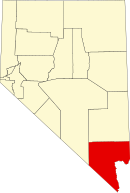Las Vegas-Henderson-Paradise, NV MSA
| Clark County, Nevada | ||
|---|---|---|
| County | ||
| Clark County | ||
|
||
| Motto: "Living Relentlessly, Developing Economically!" | ||
 Location in the U.S. state of Nevada |
||
 Nevada's location in the U.S. |
||
| Founded | July 1, 1909 | |
| Named for | William A. Clark | |
| Seat | Las Vegas | |
| Largest city | Las Vegas | |
| Area | ||
| • Total | 8,061 sq mi (20,878 km2) | |
| • Land | 7,891 sq mi (20,438 km2) | |
| • Water | 169 sq mi (438 km2), 2.1% | |
| Population (est.) | ||
| • (2014) | 2,069,681 | |
| • Density | 247/sq mi (95/km²) | |
| Congressional districts | 1st, 3rd, 4th | |
| Time zone | Pacific: UTC-8/-7 | |
| Website | www |
|
Clark County is a county in the U.S. state of Nevada. As of the 2010 census, the population was 1,951,269, with an estimated population of 2,114,801 in 2015. It is by far the most populous county in Nevada, accounting more than two-thirds of its residents. Las Vegas, Nevada's most populous city, has been the county seat since the county was established.
The county was formed by the Nevada Legislature by splitting off a portion of Lincoln County on February 5, 1909, and came into existence on July 1, 1909. The Las Vegas Valley, a 600 sq mi (1,600 km2) basin, includes Las Vegas as well as the other primary population center, the unincorporated community of Paradise.
Much of the county was part of Pah-Ute County, Arizona Territory before Nevada became a state. The county was named for William Andrews Clark, a Montana copper magnate and U.S. Senator. Clark was largely responsible for the construction of the Los Angeles and Salt Lake Railroad through the area, a factor heavily contributing to the region's early development.
Clark County is a major tourist destination, with 150,000 hotel rooms. The Las Vegas Strip, home to most of the hotel-casinos known to many around the world, is not within the City of Las Vegas city limits, but in unincorporated Paradise. It is, however, in the Las Vegas Valley.
...
Wikipedia

